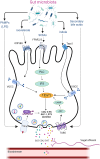Gut Microbiome Regulation of Gut Hormone Secretion
- PMID: 40037297
- PMCID: PMC11879239
- DOI: 10.1210/endocr/bqaf004
Gut Microbiome Regulation of Gut Hormone Secretion
Abstract
The gut microbiome, comprising bacteria, viruses, fungi, and bacteriophages, is one of the largest microbial ecosystems in the human body and plays a crucial role in various physiological processes. This review explores the interaction between the gut microbiome and enteroendocrine cells (EECs), specialized hormone-secreting cells within the intestinal epithelium. EECs, which constitute less than 1% of intestinal epithelial cells, are key regulators of gut-brain communication, energy metabolism, gut motility, and satiety. Recent evidence shows that gut microbiota directly influence EEC function, maturation, and hormone secretion. For instance, commensal bacteria regulate the production of hormones like glucagon-like peptide 1 and peptide YY by modulating gene expression and vesicle cycling in EE cells. Additionally, metabolites such as short-chain fatty acids, derived from microbial fermentation, play a central role in regulating EEC signaling pathways that affect metabolism, gut motility, and immune responses. Furthermore, the interplay between gut microbiota, EECs, and metabolic diseases, such as obesity and diabetes, is examined, emphasizing the microbiome's dual role in promoting health and contributing to disease states. This intricate relationship between the gut microbiome and EECs offers new insights into potential therapeutic strategies for metabolic and gut disorders.
Keywords: enteroendocrine cells; gut hormone; gut microbiome; host physiology.
© The Author(s) 2025. Published by Oxford University Press on behalf of the Endocrine Society.
Figures



References
-
- De Vadder F, Kovatcheva-Datchary P, Goncalves D, et al. Microbiota-generated metabolites promote metabolic benefits via gut-brain neural circuits. Cell. 2014;156(1-2):84‐96. - PubMed
-
- Wu T, Rayner CK, Young RL, Horowitz M. Gut motility and enteroendocrine secretion. Curr Opin Pharmacol. 2013;13(6):928‐934. - PubMed
-
- Turnbaugh PJ, Ley RE, Mahowald MA, Magrini V, Mardis ER, Gordon JI. An obesity-associated gut microbiome with increased capacity for energy harvest. Nature. 2006;444(7122):1027‐1031. - PubMed
Publication types
MeSH terms
Substances
Grants and funding
LinkOut - more resources
Full Text Sources

